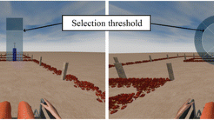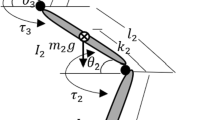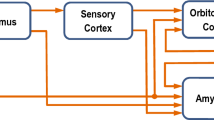Abstract
This work presents an adaptive dynamic control to solve the path following problem for the human-wheelchair system, allowing people with lower and upper extremity impairments to move a wheelchair through brain signals. The desired velocity of the wheelchair is considered as a function of the disregard of the person to move the robotic wheelchair. Additionally, the kinematic and dynamic modeling of a human-wheelchair system where it is considered that its mass center is not located at the wheels’ axis center of the wheelchair. This controller design is based on two cascaded subsystems: a kinematic controller with command saturation, and an adaptive dynamic controller that compensates the dynamics of the human-wheelchair system. Stability and robustness are proved by using Lyapunov’s method. Experimental results show a good performance of the proposed controller as proved by the theoretical design.
Access this chapter
Tax calculation will be finalised at checkout
Purchases are for personal use only
Similar content being viewed by others
References
Bastos-Filho, T., et al.: Towards a new modality-independent interface for a robotic wheelchair. IEEE Trans. Neural Syst. Rehabil. Eng. 22(3), 567–584 (2014)
Wang, Y., Chen, W.: Hybrid map-based navigation for intelligent wheelchair. In: IEEE International Conference on Robotics and Automation, China, pp. 637–642 (2011)
Cheng., W.-C., Chiang, C.-C.: The development of the automatic lane following navigation system for the intelligent robotic wheelchair. In: IEEE International Conference on Fuzzy Systems, Taiwan, pp. 1946–1952 (2011)
Mazo, M.: An integral system for assisted mobility. IEEE Robot. Autom. Mag. 8(1), 46–56 (2001)
Zeng, Q., Teo, C., Rebsamen, B., Burdet, E.: A collaborative wheelchair system. IEEE Trans. Neural Syst. Rehabil. Eng. 16(2), 161–170 (2008)
Parikh, S.P., Grassi, V., Kumar, V., Okamoto, J.: Integrating human inputs with autonomous behaviors on an intelligent wheelchair platform. IEEE Intell. Syst. 22(2), 33–41 (2007)
Soeanto, D., Lapierre, L., Pascoal, A.: Adaptive non-singular path-following, control of dynamic wheeled robots. In: Proceedings of 42nd IEEE/CDC, Hawaii, USA, 9–12 December, pp. 1765–1770 (2003)
Xu, Y., Zhang, C., Bao, W., Tong, L.: Dynamic sliding mode controller based on particle swarm optimization for mobile robot’s path following. In: International Forum on Information Technology and Applications, pp. 257–260 (2009)
Sapey, B., Stewart, J., Donaldson, G.: Increases in wheelchair use and perceptions of disablement. Disabil. Soc. 20(5), 489–505 (2005)
Emotiv Systems Electronics Company. http://emotiv.com/
Andaluz, V.H., Canseco, P., Varela, J., Ortiz, J.S., Pérez, M.G., Roberti, F., Carelli, R.: Robust control with dynamic compensation for human-wheelchair system. In: Zhang, X., Liu, H., Chen, Z., Wang, N. (eds.) ICIRA 2014, Part I. LNCS, vol. 8917, pp. 376–389. Springer, Heidelberg (2014)
Andaluz, V.H., Canseco, P., Varela, J., Ortiz, J.S., Pérez, M.G., Morales, V., Robertí, F., Carelli, R.: Modeling and control of a wheelchair considering center of mass lateral displacements. In: Liu, H., Kubota, N., Zhu, X., Dillmann, R. (eds.) ICIRA 2015. LNCS, vol. 9246, pp. 254–270. Springer, Heidelberg (2015)
Andaluz, V., Roberti, F.: Robust control with redundancy resolution and dynamic compensation for mobile manipulators. In: IEEE-ICIT International Conference on Industrial Technology, pp. 1449–1454 (2010)
Acknowledgment
The authors would like to thanks to the Universidad Técnica de Ambato for financing the project Robotic Assistance for Persons with Disabilities (Resolution: 1151-CU-P-2012). Also to the Universidad de las Fuerzas Armadas ESPE and to the Escuela Superior Politécnica de Chimborazo for the support to develop of the Master’s Thesis Control de una silla de ruedas a través de señales cerebrales.
Author information
Authors and Affiliations
Corresponding author
Editor information
Editors and Affiliations
Rights and permissions
Copyright information
© 2016 Springer International Publishing Switzerland
About this paper
Cite this paper
Andaluz, V.H., Ortiz, J.S., Chicaiza, F.A., Varela, J., Espinosa, E.G., Canseco, P. (2016). Adaptive Control of the Human-Wheelchair System Through Brain Signals. In: Kubota, N., Kiguchi, K., Liu, H., Obo, T. (eds) Intelligent Robotics and Applications. ICIRA 2016. Lecture Notes in Computer Science(), vol 9835. Springer, Cham. https://doi.org/10.1007/978-3-319-43518-3_22
Download citation
DOI: https://doi.org/10.1007/978-3-319-43518-3_22
Published:
Publisher Name: Springer, Cham
Print ISBN: 978-3-319-43517-6
Online ISBN: 978-3-319-43518-3
eBook Packages: Computer ScienceComputer Science (R0)




